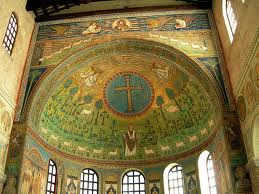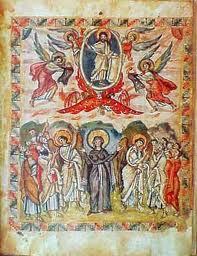|
With the rise of the Byzantine Empire from the 5th century onwards, centred on Byzantium (now Istanbul, Turkey), the art form took on new characteristics. These included Eastern influences in style and the use of special glass tesserae called smalti, manufactured in northern Italy. These were made from thick sheets of coloured glass. Smalti have a rough surface and contain tiny air bubbles. They are sometimes backed with reflective silver or gold leaf.

The style in which these mosaics and frescoes were executed reflected their function as static, symbolic images of the divine and the Absolute. The mature Byzantine style, evolved through the stylization and standardization of late classical forms of Early Christian art, was based on the dynamic of lines and flat areas of colour rather than form.
Individual features were suppressed in favour of a standard facial type, figures were flattened, and draperies were reduced to patterns of swirling lines. The total effect was one of disembodiment, the three-dimensional representation of an individual human figure replaced by a spiritual presence the force of which depended upon vigour of line and brilliance of colour. The Byzantine image was at once more remote and more immediate than the naturalistic classical one.

Byzantine art is generally taken to include the arts of the Byzantine Empire from the foundation of the new capital of Constantinople (now Istanbul) in AD 330 in ancient Byzantium to the capture of the city by the Ottoman Turks in 1453.
The territory of the Byzantine Empire originally encompassed the entire eastern half of the Roman Empire around the Mediterranean Sea but shrank to little more than Greece, part of southern Italy, the southern Balkans, and Anatolia after the Islamic invasions of the 7th century.

In the period after the 12th century, the empire comprised little more than Constantinople and a few other outposts. The influence of Byzantine art, however, extended far beyond these borders, because arts derived from Byzantium continued to be practiced in parts of Greece, the Balkans, and Russia into the 18th century and, in some isolated monasteries, to the present day.
The style of Byzantium Art was characterised by: pietistic painting (religious art); artists were members of religious houses such as monasteries; there were no sculptures as these were looked upon as a form of idolatry; Sombre tones; Byzantine Art was totally flat - one dimensional.
There was no perspective; there were no shadows; Figures in Byzantine Art were generally depicted front-facing; Byzantine Art featured long, narrow and solemn faces and there was no attempt to portray realism in sombre Byzantine Art.
|

![]()


